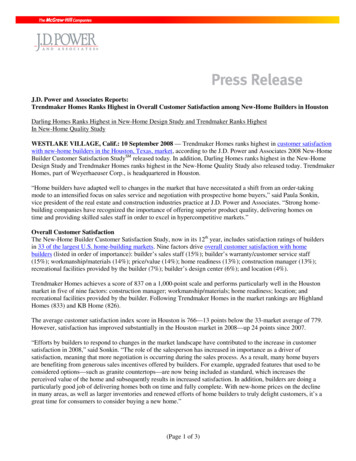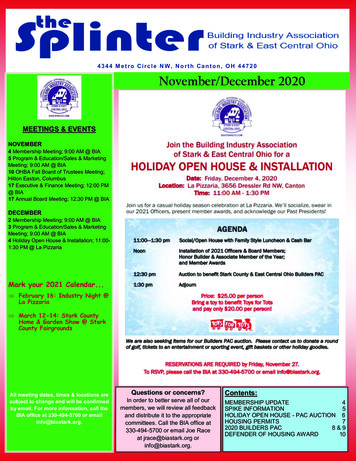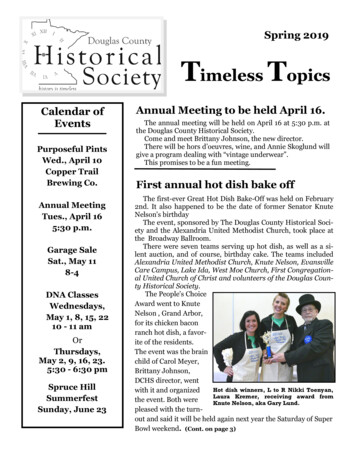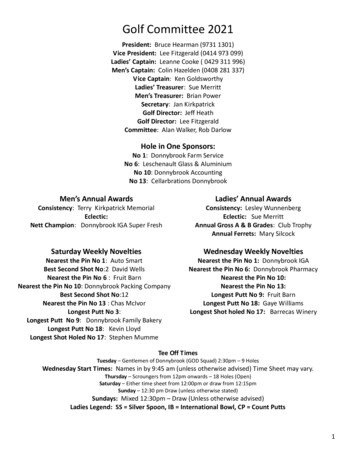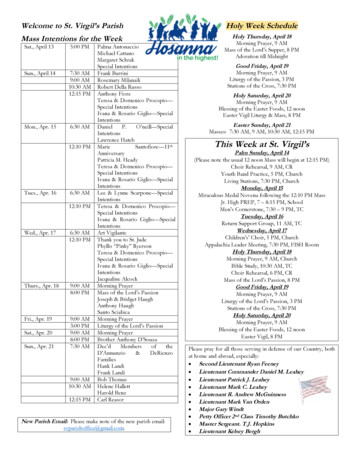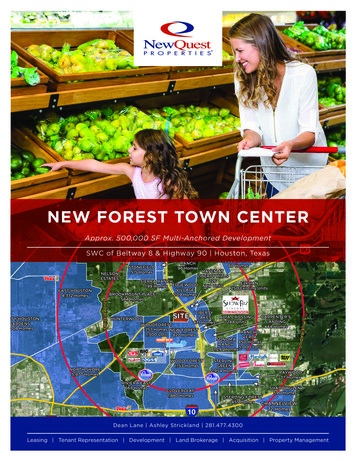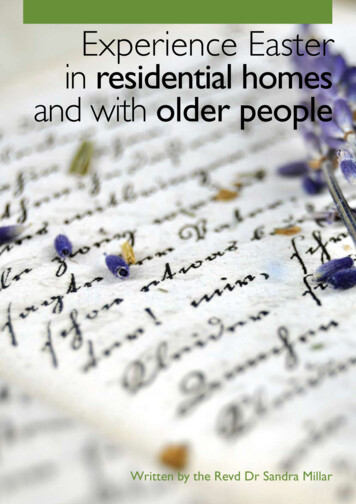
Transcription
Experience Easterin residential homesand with older peopleWritten by the Revd Dr Sandra MillarExperience Easter with residential homes and older people1
How to use this packThis pack contains a series of ideas for talks andactivities with those in residential care homes. It maybe that you only make one visit during the seasonor Lent and Easter, or you may choose to offer amorning with more than one story or activity.You will need to acquire a very special box to useas the treasure box. Inside it you will need to havea special cloth: you may like to change the colourof the cloth from purple to gold depending on theappropriate liturgical colour at the time of your visit.The box also needs to be large enough to containone or more of the items at the heart of eachprogramme – the largest item is some home bakedbread and a small water spray.It may be appropriate to have enough items to giveor hand round to each member of the group. Thesemight be in the box or kept separately.One item might be left behind for display in a suitableplace, depending on the layout and needs of theresidential home.Each session is based around talk and reminiscenceand involves telling a simple story, with an optionalcraft activity. It is important to give plenty of time totalk.The materials could also be used with other groupsof people eg in day centres or lunch clubs.Starting a sessionIt is helpful to have some clear indicator that the time is moving from a more informal chat towards a morepurposeful input. This might be lighting a candle and using a simple response such as: “The Lord be with you”.“And also with you.”Begin by placing the box in a visible place, such as a table.Open it respectfully and then take out the cloth, placing it on the table, with the open box nearby.Say: This is the place for the treasure of memory. This is the place for the treasure of Easter.Experience Easter with residential homes and older people2
Getting ready: The story of LentIn the boxA container with ash from a fire; a container with ashfor Ash Wednesday.Take out the ash from a fire and begin to talk aboutwhat it might be. Pass it round, invite people to smellit. If the memories of fires in the grate don’t startflowing, you might prompt with a story of your own.Talk about coming down on cold mornings to thejob of clearing the ash away; of the struggle to lightfires etc. But also talk about the joy of seeing the fireburning.Then take out the container for Ash Wednesday. Passit round. Ask if anyone can remember being in churchfor Ash Wednesday, the feel of ash being placed onyour forehead as a sign that the season of Lent isbeginning. Explore memories of Lent, about givingthings up, about eating fish and no flowers in church.The storyThe way we behave in Lent is inspired by Jesus. Afterhe was baptised, and before he began the work ofteaching and healing that would bring such joy thatcrowds followed him everywhere, and such angerthat it would lead to his death on the cross, Jesustook time away from everyone.You might remember the story:Luke 4: 1-13 Either read from the Bible version withwhich most people are familiar ORJesus was baptised by John the Baptist in the Jordan.As he walked away, he knew that God was with himand loved him, and he was so aware that God’s spiritwas with him. Jesus walked on, further and further awayfrom the villages, the houses, the farms, even the trees.He walked right into the wilderness. Day after day hethought and prayed. Day after day he ate nothing anddrank little. Forty long days went by, and Jesus wasfamished – famished of food, famished of company, andthe Devil stepped in and began to taunt him.“Why go hungry Jesus? If you are really the son of God,you could turn all these stones into lovely, tasty loavesof bread.”Jesus spoke firmly. “The scriptures tell us that humanbeings do not live by bread alone.”Experience Easter with residential homes and older people3
Getting ready: The story of LentThe Devil continued. He showed Jesus all the kingdomsof the world spread out before him – all the cities, allthe people, all the beauty. And the Devil said to Jesus:“All this could be yours. All you have to do is worshipme.”Jesus spoke firmly: The scriptures tell us to worship andserve God and God alone.But the Devil continued to torment Jesus. He took himto the highest point of the temple and said: “If you arethe Son of God, throw yourself off. You know that Godwill send his angels to protect you. Not a bone of yourbody will be harmed.”Craft activity: Painted prayer stoneYou will need: Enough smooth, large pebbles for everyone. Appropriate paints eg enamel. Paint brushes. Some design ideas for copy eg a cross, flowers,a dove etc.Each person chooses a design and paints thestone.Leave to dry.Jesus spoke firmly:” Scripture says do not test the Lordyour God.”So the Devil left Jesus. And Jesus left the wilderness.After reading the story, continue with a shortconversation about any memories of the story.It may be appropriate to introduce a short timeof reflection and penitence, before offering theimposition of ashes to those who want it. Alternatively,pray using these or similar words:Lord Jesus,who struggled, but who stood strong when theDevil spoke,help us who struggle to be strong,and to be faithful in following youwhen life feels good and when life feels difficult.In Jesus’ name.Amen.End with a blessing.Experience Easter with residential homes and older people4
On the move: The story of Palm SundayIn the boxEnough palm crosses for everyone; an unmade palmcross.Open the box and place one of the palm crosses onthe fabric. If you are able, make a palm cross whilstyou talk. Pass one or more crosses round the group.Begin to talk about whether people have held onebefore. Where do they keep it when they get home?Add a story of your own if appropriate. Encourageconversation about processions and donkeys, beingoutdoors, a very long service, music.The storyPalm crosses are given out on Palm Sunday, oftena service with a procession. We hear the story ofJesus last week as we get ready to remember againeverything that happened. We also remember thatfirst time, when Jesus rode into Jerusalem on adonkey. It must have been amazing to be there; thenoise, the smells, the crowds pressing in.You might remember the story:Luke 11 1 – 11: read from the Bible version withwhich people are most familiar OR Trevor Dennis,Book of Books page 370 -373 ORJesus called his disciples together. Go down there andwhen you find a donkey and her colt, bring them backto me.The disciples went and found the donkey just as Jesushad said. They brought her back to Jesus. Then Jesusgot on the donkey, and they began to walk towardsJerusalem. Crowds gathered along the way. Childrenstarted shouting “Hosanna! Hosanna! Hurray!! Hurray!”Everyone began to join in, cheering and shouting. Theypulled palm branches from the trees and threw them infront of the donkey. It was like a royal procession. It wasa procession fit for a king. Jesus was the king.After reading the story, continue a conversationabout memories of Palm Sunday.Hand out palm crosses to each person present andencourage them to hold it as you pray in these orsimilar words:Experience Easter with residential homes and older people5
On the move: The story of Palm SundayLoving God,As we hold this palm cross,help us to remember that you are a King,and that you are a Saviour.Help us to give you praise and thanksin the quiet moments of our days,and help us to remember your presencein the long stillness of the nights.In Jesus’ name we pray.Amen.End with blessing.Craft activity: A ‘Gomez’ cross (see colouredcross in the picture above)Divide a cross shape into seven segments –four longways, three across. Each segment isillustrated to represent either something fromthe story of Jesus or aspects of the story ofsomeone’s life egCentre – sunrise for resurrectionTop panel – crown of thornsNext panel – jug and bowlBottom panel – scene of praying in the gardenLeft side – donkeyRight side – bread and wine.Experience Easter with residential homes and older people6
Pause for thought: the story of the anointing with oilIn the boxSome solid/spray perfume (perhaps from the 1950sor 60s eg Avon), a scented candle, a lavender sachet.Place the scented candle on the fabric, and pass thesolid perfume around. Invite people to smell theperfume. Encourage conversation about how smell isvery evocative of different situations. Talk specificallyabout perfume, talking about times when perfume hasbeen special. Think about when it was given, who gaveit, whether it signified something special. Perfume isoften given as a sign of love.Jesus was in Bethany at the house of Simon the leper.Jesus was always around people that he shouldn’t bewith. And unusual things were often happening aroundJesus.The storyWhilst the men were sitting around talking, a womancame quietly into the room. No-one paid her anyattention: they probably thought she was a servant.She moved as quietly as she could until she came closeto Jesus. Then from under her shawl, she pulled out asmall bottle, pulled out the stopper and then pouredthe contents all over Jesus. A beautiful perfume filledthe room. Everyone began to talk, their voices full ofirritation, even anger.Perfume is often given as a sign of love, and it’s notjust a modern invention. There was a time whensomeone poured perfume all over Jesus as a tokenof love. You might remember the story:“This is really expensive perfume. It should have beensold. The money could have been given to the poor.”They began to rebuke the woman.Read Mark 14: 3-9 or John 12 1- 8 from the Bibleversion with which people are most familiar ORExperience Easter with residential homes and older people7
Pause for thought: the story of the anointing with oilJesus thought differently. He said to those listening:“Leave her alone! This woman has done somethingreally special for me. There will always be people inneed – and you can help them whenever you wish. Butthis woman has done what she can – she has anointedmy body for burial ahead of time. You might not believethis, but whenever people are told the good news, whatshe has done will be remembered.”Take some time to reflect further on the memoriesof perfume and love and what this might have meantfor Jesus. Pray in these or similar words:Lord Jesus,We know you come to us with love,and have blessed us with love in our lives;help us to show love to you in our words andactions,and help us to show love to those around us,in our families, amongst our friends,and in this place.In Jesus’ name. Amen.End with a blessing.Craft activity: Lavender bagsThis is a very simple way to make lavender bags.Lavender is the herb of healing, and you mightwant to encourage people to make their bag(s)for someone else as a token of their thoughtsand prayers.You will need:6 or 7 squares of fabric for everyone.Dried lavender.Craft elastic bands.Pretty matching ribbon.Take a square of fabric. Place a small handfulof lavender into the centre. Gather the edgesaround the lavender and secure with an elasticband. Then simply tie a length of ribbonaround.ORCraft activity: Decorated candle holderDecorate a simple glass as a holder for a tealight.You will need: Wooden or glass candle holders (availablefrom craft suppliers such as Baker Ross) Appropriate paintsAfter decorating, place a scented candle into inthe holder.Experience Easter with residential homes and older people8
More than bread: The story of the last supperIn the boxSome home baked bread, which needs to be largeenough to share. You might also want to have thesmell of home baking, perhaps by using a scentedcandle.Place the bread on the fabric.Show the bread and talk about bread, about breadmaking, and other domestic activities. There might bememories of food shortages, whether in the war orbecause of strikes in the 1970s. Draw out memoriesof meals around the table, talking about specialoccasions.The storyBread is such an ordinary thing. Yet it means so muchto us – it reminds us of the essential things of life,reminds us of happy times and sad times as well,makes us think about sharing, but also about what isreally important in life.Jesus used bread in both these ways when he metwith his disciples for the last time.Read Luke 22: 7 -13 from the Bible version withwhich people are most familiar ORIt was the night of the Passover. Everything had beenmade ready for Jesus and his friends to share the specialmeal together.As they were gathered around the table, sharing thePassover meal, Jesus took some bread. He gave thanks toGod, and broke the bread, saying: “This is my body, givenfor you. Every time you do this in the future, rememberme.” Then he took the cup filled with wine, gave thanksto God, and said: “This is my blood, given for you. Everytime you drink this in the future, remember me.”Time was running out.Shortly after, Jesus and the disciples left the room andwent out to the Garden of Gethsemane to pray.Take some time to reflect together, continuing tothink about special meals and particularly about HolyCommunion.You might remember the story:Experience Easter with residential homes and older people9
More than bread: The story of the last supperPray using these or similar words:Craft activity: Ornamental breadLoving God,Thank you for the good things we have in ourlives,For food, friends and family gathered together.Thank you for the special things we have in ourlives,for the gift of bread and wine,as we gather together and remember youand all that you mean to us.Draw close to us today and help us know yourpresencein the ordinary things of our lives.Amen.Use salt dough to make ornamental bread.You will need:2 cups of plain flour1 cup of cooking salt¾ cup of waterMix the salt and flour together with a spoon.Gradually add half a cup of water and keepmixing. Add water until the mixture reachesthe desired consistency and you can roll it intoa ball. Knead the dough for a few minutes tomake sure it has been mixed fully. Make shapesand leave for 48 hours to dry. Glaze if desired.Finish with blessing.Experience Easter with residential homes and older people10
Water, water, everywhere: The story of the foot-washingIn the boxA small water spray, a towel and some basic soap.Place the towel and the soap onto the cloth. Gentlyspray people with the water, and then talk about whatwater is used for. Draw out memories of weeklybaths, laundry days, using the same water many times.Talk about when there is too much water, reminiscingabout floods and washing machine disasters etc.Place the water spray back on the fabric.The storyWater is easy to take for granted, and the thingswe use water for are taken for granted. Jesus didsomething that was both very ordinary and veryspecial with some water.Everything was ready for Jesus and the disciples to sharea meal together. The meal had already begun, whenJesus did something unexpected. He stood up, took ofhis robe, and wrapped a towel round his waist. Then hebegan to wash the feet of those around the table.Most of the disciples were too shocked and embarrassedto speak – except Peter.Peter said: “Jesus, this can’t be right! You are my teacher,my master. It’s not for you to wash my feet.”After he had washed everyone’s feet, Jesus sat downagain. He asked the disciples a question: “Do you realisewhat I have done for you? If I, your Lord and Master,wash feet, then this is something you should be doingfor others. I have set you an example, an example youshould follow as you behave towards other people theway I have behaved with you.”You might remember the story:Read John 13: 1-11 in a familiar Bible version ORReflect on the story, talking about feet and howpersonal it might seem to have your feet washed.Experience Easter with residential homes and older people11
Water, water, everywhere: The story of the foot-washingPray in these or similar words:Creator God, who made the world,gave us water as the source of life,and showed us how to care for one another,help us to show care to those around us,to make small gestures of kindnessand to share love with all those we meet.In Jesus’ name, we pray.Amen.End with blessing.Craft activity: Felt makingYou will need: Raw wool Washing up liquid Bowl of hot water. Bowl of cold water. Towel.Pull the raw wool apart and fluff it up. Wet yourhands with warm water and put a little bit ofwashing up liquid on your hands. Gently rollthe wool into a ball. As it begins to felt, pressharder so it stiffens and flatten it out. When it isfirm, rinse it with cold water and press it in thetowel. Allow it to air dry and cut it into desiredshapes.ORMake and decorate a small gift box to give tosomeone as an act of kindness.Experience Easter with residential homes and older people12
Sound of silence: The story of PeterIn the boxA small ornament of a cockerel and a sound effectCD. Place the cockerel on the cloth and play thesome of the sound effects from the CD. Talk aboutthe memories triggered by sounds and noises. Forexample, the sound of thunder might bring backmemories of a storm. You might want to play somemusic from appropriate eras eg early rock or a swingband.Then play the sound of a cock crowing. Talk aboutwhether it has any memories for anyone. Somesounds remind us of happy times, but some soundsremind us of difficult or disappointing events.The sound of the cockerel crowing must have beenvery significant for Peter. You might remember thestory.The storyHigh Priest’s house. Peter tried to stay close, weaving inand out of the shadows, so he couldn’t be seen.A fire was blazing in the middle of the courtyard, andthe soldiers and servants gathered around. Peter slid inamong them. One of the servant girls saw him and said:“I reckon he was with Jesus.”Quickly Peter moved back and said loudly: “Woman, Ido not know him.” The night dragged on, and a whilelater another servant saw Peter and said: “ You are oneof them, the friends of Jesus.” Peter swore loudly andsaid: “Man, you must be joking! I am not one of them.”Time went by. About an hour later as dawn light creptinto the courtyard, still another servant came to Peterand said: “This bloke is from Galilee. He must havebeen with them.”Peter spoke more firmly than ever: “Man, you do notknow what you are talking about! Leave me alone!”At that moment a cock crowed.Read Luke 22: 54 -62 in a familiar Bible version ORThe soldiers led Jesus away from the garden where hehad been praying with his friends. The disciples scatteredin fear as they dragged Jesus into the courtyard on theJesus turned and looked across the courtyard, right intoPeter’s eyes.Experience Easter with residential homes and older people13
Sound of silence: The story of PeterAnd Peter remembered. He remembered the mealthey had shared. He remembered how he had boastedand bragged that he would never let Jesus down. Heremembered how Jesus had shaken his head and said:“Peter, this very night, you will deny me three times.”Even then Peter had laughed with bravado, so sure ofhimself. He remembered now.And he turned and ran from that place, the cock crowringing in his ears, and his eyes blinded by tears.Reflect on this story and any further memoriesbefore praying in these or similar words:Loving God,you have promised to be with us all the time,when things go well and when things aredifficult,when we fail you and disappoint others.Be with us today, give us courage to face ourchallenges,and peace in knowing your presence.Amen.Craft activity: Cockerel book markYou will need: Enough pictures of cockerels for everyone. Cardboard. Scissors Glue.Print out pictures of cockerels and glue themonto cardboard, cutting around the shape. (Ifmembers of the group are likely to find thishard, bring ready cut shapes.) Stick them ontothe top of a two inch by seven inch piece ofcardboard so that the cockerel’s comb sticksout over the top of the bookmark.Experience Easter with residential homes and older people14
The end: The story of the crossIn the boxOne or two crosses from church/chapel, including acrucifix, plus enough holding crosses for each person.Take the crosses out of the box and place on thefabric.Ask if anyone can remember seeing a cross like these– perhaps in a church or chapel, perhaps at a warmemorial. Talk about any particular occasions peoplecan remember, such as a church which was special. Butalso talk about how the cross makes people feel. Forsome people the cross will have strong associationswith loss, death and sadness. It may even make somepeople feel anger or disgust. Others may want tobegin talking about times when it was really helpfulto them.The cross is very important to Christians. Show thecrucifix: it reminds us of the fact that Jesus died on across, put to death by his enemies. Show the emptycross: it reminds us that his body was taken down andlaid in a tomb, borrowed from a stranger and waitingfor new life again.The storyEither read Mark 15: 2- 47 from a familiar version ofthe Bible ORThe crowd made their choice. The soldiers finishedtormenting Jesus. So began the long walk up the hill tothe place where people were crucified. Crowds watchedas Jesus struggled, some laughing at him, some crying.Jesus stumbled, and the soldiers grabbed a man fromthe crowd to help him. Simon was only there for the daywith his sons, but he had no choice. He shouldered thecross and walked with Jesus.At the place called Golgotha, the soldiers nailed Jesus tothe cross, and raised it high. The soldiers sat down towait, and as they waited they gambled for his clothes.It was nine o’clock in the morning when they crucifiedJesus. There were others there, thieves and robbers, alsoleft to die. People walked by and laughed at Jesus,calling out to him: “Come on down and save yourself ”.The temple leaders came by and shouted: “Come downfrom the cross, come down and make us believe.” ButJesus said nothing.You might remember the story:Experience Easter with residential homes and older people15
The end: The story of the crossThree hours later, at noon, everything went dark. andit stayed dark until three in the afternoon. It was such along day. Then Jesus called out and the soldiers thoughthe wanted a drink. They offered wine vinegar on a stick,but Jesus took nothing. He gave a loud cry, and thenhe was dead.At that exact moment the curtain in the temple rippedin half.One of the soldiers waiting at the cross looked at Jesusand said: “Truly, this man was the Son of God.”Only the women who followed Jesus were there. All hisfriends had run away.It was a terrible day.Pause for a short time or play a well-known Good Fridayhymn, such as “There is a green hill far away” or “WhenI survey the wondrous cross.”Then continue to talk about memories of GoodFriday – perhaps thinking about any special customs,visits to church, eating fish, shops being closed etc.Then hand everyone a holding cross. Encouragethem to hold it close as you pray in these or similarwords:Craft activity: Good Friday braceletYou might like to make a simple Good Fridaybracelet that tells the story of the journey tothe cross.You will need: A selection of coloured beads. Some jewellery thread (waxed nylon orequivalent). Needles.Choose a series of coloured bead to representdifferent moments of the story – purple for themocking and trials, red for the cross, black forthe death and gold for the hope of new life.Thread them in between a different neutralcolour and tie together to make either a braceletor necklace.If your parish has sufficient resources, you mightbe able to give a holding cross to those whowant to keep one.Lord God,Good Friday ought to be bad Friday,as we remember Jesus put to death on the cross.We remember all the dark times in our own livesand the dark times in our world;and as we look at the cross,we know that Jesus shares all our pain,and bears all our wrong-doing.Give us courage and give us hopeas we trust in you to bring us to new life again.In Jesus’ name we pray. Amen.End with blessing.Experience Easter with residential homes and older people16
New beginning: The story of EasterIn the boxThe storyA banana and an orange, an empty cross, a large stoneand some daffodils. You might also like to have somechocolate eggs to give away.Read Luke 24: 1-11 in a familiar Bible version or“Mary” p398 in Book of Books by Trevor DennisORTake the banana and orange from the box first.After the burial, after the Sabbath, after long sleeplessnights and after long weary hours of grief, the womenwanted to do something. Mary, from the town ofMagdala, and some of the other women who knewJesus, crept out in the early morning light. They walkedquickly, quietly, to the place where Jesus’ body had beenleft. They were ready to put more spices and herbsnearby. But as they drew closer, they realised that thestone had already been moved! They were shockedand worried. What could have happened? Then twomen in dazzling white clothes came and stood nextto them. Now the women were not just shocked andworried – they were absolutely terrified, so terrified theybowed low to the ground.Ask if anyone can remember the first time they sawone of these. Talk about rationing and shortages, andhow it felt when that time was coming to an end, howit felt like a new beginning.Then take out the daffodils and talk about springmemories, the joy of gardening and seeing new thingsappear.Finally take out the cross and the stone, and beginto talk about Easter. Talk about memories of Easterday, any special customs, eggs, Easter bonnets, newclothes, flowers.Easter Day is the greatest day in the Church calendar.Perhaps you can remember the story.One of the men said: “Why are you looking for theliving here in the place where the dead belong? Jesusis not here, he is risen. He is alive!” The women didn’tknow what to feel or think: shock, worry, fear, delight,Experience Easter with residential homes and older people17
New beginning: The story of Easterexcitement – so many feelings all at once. They lookedat each other – and they ran. They ran back throughthe streets, back through the morning light, back to thehouse where many of Jesus’ friends were waiting andwondering, crying and talking. They burst in throughthe door. Peter, John, James, all the men looked up inamazement. Mary looked at them for a moment. Thenshe said: “He is alive! Jesus has risen from the dead!”But the men laughed at them. “What do a bunch ofwomen know?” they thought. Except Peter. Peter pushedpast them all and ran, ran through the streets as thesun rose higher in the sky. He ran right into the tomb.Then he stopped. There was nothing there except a fewempty sheets and a few stale herbs.Slowly he walked back, stunned, amazed and full ofjoy. Suddenly, he jumped high and punched the air:“Alleluia!” he shouted. Alleluia! Alleluia! Alleluia! Alleluia!The shout echoed round and around.Everything had changed. Jesus is alive again Craft activity: Painted egg shellsYou will need: An empty egg shell for each group member(see directions below). Felt tip pens or poster paints. Cotton. A branch or tree for display.Before the session, prepare an egg shell for eachgroup member. Make a hole in both ends of anegg, with a slightly larger hole in the wider end ofthe egg. Push a needle through the larger hole,pierce the yolk and break up the membranes.Give each participant an egg shell and felt tippens or poster paints to create a decorativeegg. Try threading a piece of cotton through thecentre of each egg, so that they can be displayedon a decorative Easter tree or branch.Encourage everyone to shout alleluia as they areable. Talk about how exciting it is to celebrate goodnews and if appropriate, talk about times when goodnews has been shared or received. Then hand outchocolate eggs to share and pray in these or similarwords:Almighty God,We thank and praise you for the good newsthat Jesus is alive.We thank and praise you that your mightypowerrolled back the stone,and that life has triumphed over death.Fill our hearts with joy and hope,and give us confidence to share the good newswith those around us.In Jesus name.Amen.End with blessing and Easter egg eating! Gloucester Diocesan Board of Finance 2012.The contents of this document may not be reproduced in whole orin part without the written permission of theGloucester DBF, Church House, College Green,Gloucester GL1 2LY. Tel: 01452 410022.Registered in England No. 162165. Registered Charity No. 251234.Written by the Revd Dr Sandra Millar.Experience Easter with residential homes and older people18
Amen. End with blessing. Craft activity: A ‘Gomez’ cross (see coloured cross in the picture above) divide a cross shape into seven segments – four longways, three across. Each segment is illustrated to represent either something from the story of Jesus or aspects of the sto
